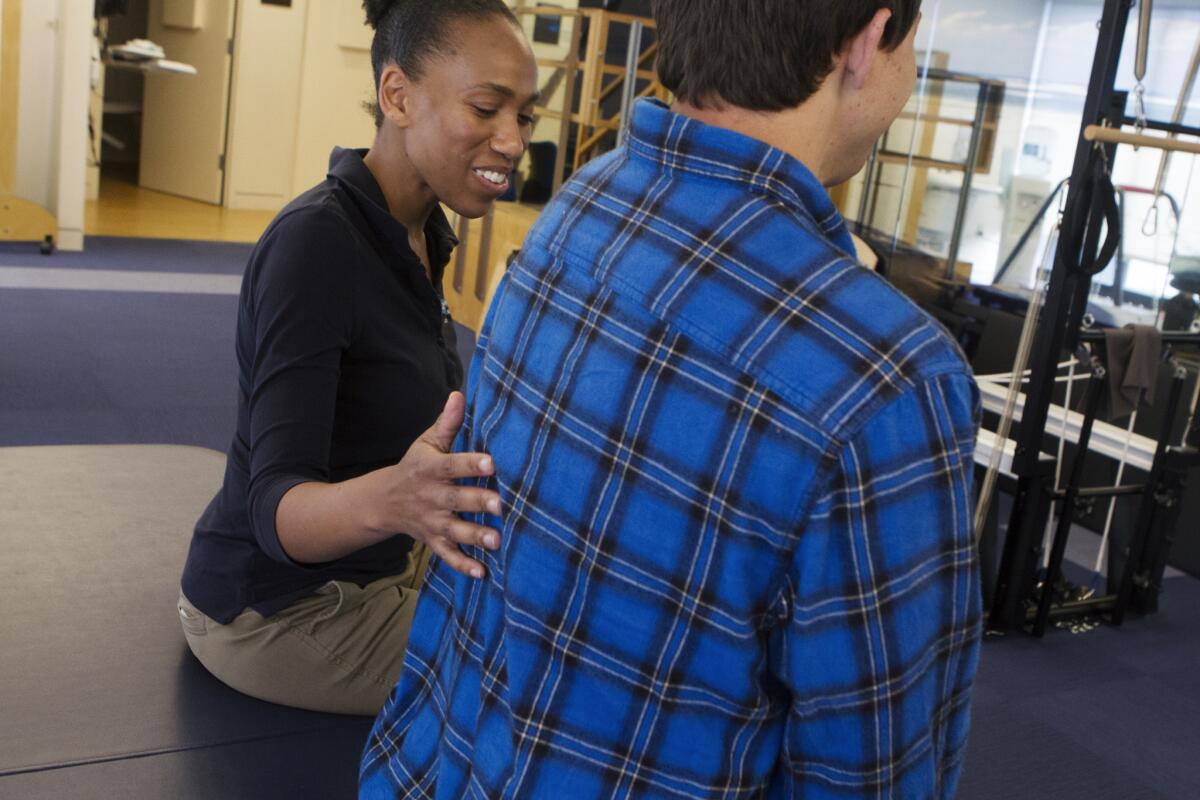The spine gives structure to your life: Keep it fit with good posture

UCLA physical therapist Keri Pegram, left, shows what good and bad posture looks like to her patient, Nathan Moore, 22, at UCLA Rehabilitation in Santa Monica.
- Share via
Christiane Carman believed she had good posture. Then one day she woke up with a crick in her neck, a nagging little pain on the left side that didn’t go away. Soon it was shooting down her left arm. By the time she landed at UCLA’s Spine Clinic, the pain had become her everyday companion. Your problem, a physical therapist at the clinic, Keri Pegram, told her, is the way you sit at work. In other words, Carman had poor posture.
Posture can seem the sort of problem that is easily corrected. But when poor posture becomes a habit, experts say, it can lead to a host of problems, including back pain, ancillary injuries in the shoulders and knees, and struggles with balance and endurance.
“The more the muscles have to work,” said Alan Hilibrand, an orthopaedic spine surgeon and professor at Philadelphia’s Jefferson Medical College, “the more they get stressed and fatigued.”
Joint issues and back pain are the second and third most common chronic issues for which we see the doctor (after skin conditions like acne), according to a 2013 Mayo Clinic study. All told, Americans spend about $50 billion each year on lower back pain issues, reports the National Institute of Neurological Disorders and Stroke, part of the National Institutes of Health.
“It’s rare that a person does not have back pain in their lives in modern times,” said Esther Gokhale, a posture expert and teacher in Silicon Valley.
Often, poor posture is at the root of the problem.
“When someone has pain that’s going all over the place — you know, when they say, ‘I have knee pain and shoulder pain,’ I’ll say, ‘No, you’ve got to fix your posture,’” Pegram said. “It always comes back to the core.”
But many of us don’t even know where to begin. Told to stand up straighter, we throw our shoulders back and our chest forward. But that’s not good posture; that’s just reversing the problem.
“Good posture is balanced posture,” said Wendy Katzman, an associate professor of physical therapy and rehabilitation science at UC San Francisco. “The head is over the torso, which is over the pelvis.”
And good posture isn’t just about standing. Sometimes we do the most damage when we sit incorrectly.
Pegram advises clients to sit on their hands and move around until they can feel the two bones at the bottom of their pelvis. “If you are on your tailbone,” she says, “you are already slouching. Even if it’s just a little bit, you are hurting your posture.”
What if you’re still not sure if you’re moving correctly? Or you simply forget? These days, of course, there are products to come to your rescue. The SitSmart device, by BackJoy, eases your fanny into the correct, upright position while you sit. The Up shirt, a fashion-forward T-shirt made in France, will push you back to proper posture when you start to slouch — and set you back a cool $150 in the process. And a smart device called the Lumo Lift will attach to your shirt or bra strap and ping when you slump — in addition to recording steps taken and calories consumed.
Gokhale wrote a book on the subject (“8 Steps to a Pain-Free Back”) and offers a six-class series on posture. Rajesh Natarajan, 45, of Los Gatos, Calif., took her classes after suffering from months of lower back pain and bouncing unsuccessfully from one practitioner to another. These days, he still has back spasms, but they resolve within a day, rather than lasting weeks or months.
“I discovered the basic logic of her teaching is: If you find a way to elongate your spine, your body stays in alignment,” said Natarajan. “The way you walk, stand, sit, it all has an impact.”
As for Carman, she’s learned tricks like not leaning into her computer when she types and pulling herself upright, rather than slouching, when she sits.
“It’s all little changes, but they make such a tremendous difference,” she said. “The question is: How can you be kinder to your spine, which is what holds you up so nicely?”
::
Tips to improving posture
Want to improve your posture? Here are three suggestions from Keri Pegram, a UCLA physical therapist:
--Find your sit bones. Those are the pressure points beneath your pelvis. Make sure you are sitting on them, and not your tailbone. Your tailbone should feel like it is behind you, and while you’re at it, your feet should be on the floor or a foot rest.
--Get a lumbar support cushion for your chair. That way you’re not always straightening yourself in your seat and you’re not straining your back, either
--Strengthen your core muscles, particularly with plank exercises. A proper plank position looks like a push-up, except your elbows are bent at 90 degrees and you’re resting your weight on your forearms. Your elbows should be right below your shoulders and your body should be in a straight line from your head to your feet. Try to hold the position for at least 10 seconds, working up over time to a goal of one minute. If forearms is too difficult or painful, start with your arms straight instead.






